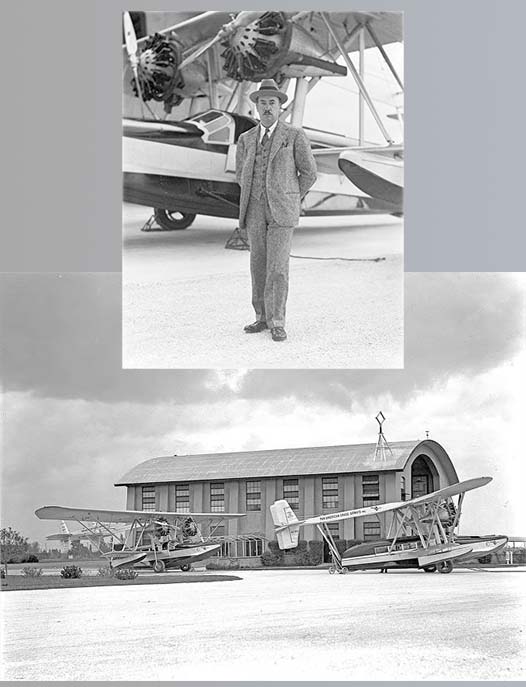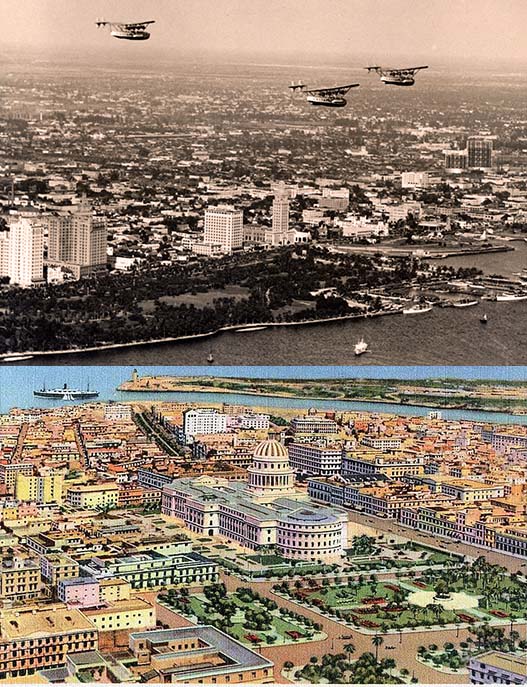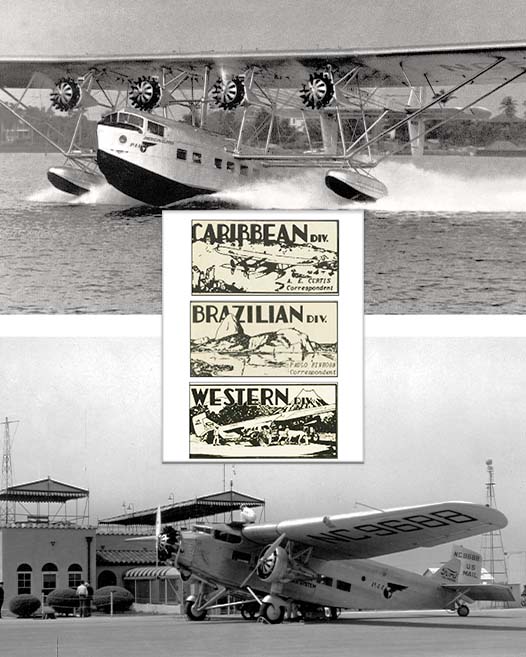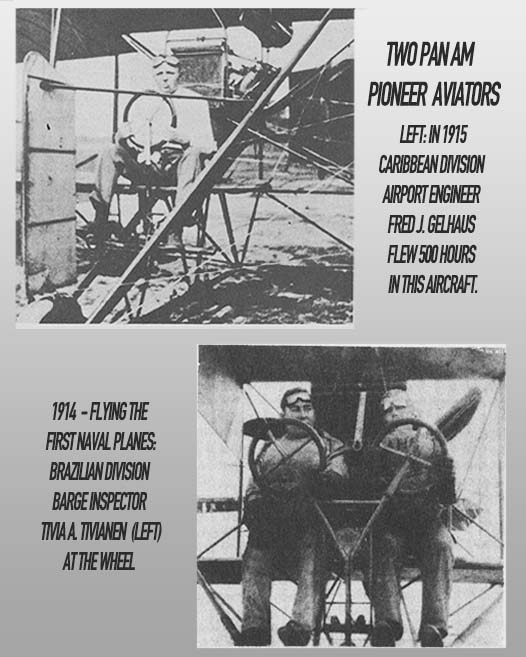APRIL 1933
Scroll down to read
Four April 1933 posts

APRIL 5, 1933
“Last of Pan Am’s First Flying Boats”
 Photos by Gleason Waite Romer, from the Helen Muir Florida Collection, Special Collections and Archives.,Miami-Dade Public Library System. (1) Igor Sikorsky in front of S-38: Aviator Igor Sikorsky passenger of Pan American Airways' "Havana Clipper.” 3-26-33. .https://digitalcollections.mdpls.org/digital/collection/p17273coll3/id/15499/rec/2 (2) NC18V and NC19V delivered to Panagra, April 1933. Pan American Airways: Two Sikorsky amphibian planes at 36th Street Airport, ready for Havana trip. 3-26-33. https://digitalcollections.mdpls.org/digital/collection/p17273coll3/id/12326/rec/37
Photos by Gleason Waite Romer, from the Helen Muir Florida Collection, Special Collections and Archives.,Miami-Dade Public Library System. (1) Igor Sikorsky in front of S-38: Aviator Igor Sikorsky passenger of Pan American Airways' "Havana Clipper.” 3-26-33. .https://digitalcollections.mdpls.org/digital/collection/p17273coll3/id/15499/rec/2 (2) NC18V and NC19V delivered to Panagra, April 1933. Pan American Airways: Two Sikorsky amphibian planes at 36th Street Airport, ready for Havana trip. 3-26-33. https://digitalcollections.mdpls.org/digital/collection/p17273coll3/id/12326/rec/37
Igor Sikorsky stood outside Pan American Airway’s Miami 36th Street passenger terminal Sunday March 26, 1933, as Gleason Romer angled to snap the aircraft designer’s portrait framed by one of the two Sikorsky S-38 flying boats which were ready to depart. Sikorsky was accompanying Pan American-Grace Airways (PANAGRA) pilots K. C. Hawkins and J. T. Kirkland, to Havana, Cuba, en route to Cristobal, Panama to deliver Pan Am’s last S-38 order, NC18V and NC19V.
Pan Am was the Sikorsky Aviation Corporation’s major S-38 client and it’s thirty-eight units eclipsed the company’s second-place user, the U.S. military, by sixteen aircraft. Starting with NC8000, delivered October, 31, 1928, the S-38 was Pan Am’s perfect aircraft for Caribbean, Central and South America, and China route planning, testing, and establishment. Pilots reported that the aircraft was reliable, easy to service, fit for remote and rugged conditions, could take a beating, carry high weight loads, and fly on one engine almost as well as two.
NC18V and NC19V were the last S-38s that Pan Am purchased new; by March 1933, the design was obsolete and Pan Am bet its near future on four newer Sikorsky designs, the S-40, S-41, S-42 & S-43.
As Igor Sikorsky left Miami that Sunday, two other crated S-38s (NC16V and NC17V) sat in a Savannah, Georgia warehouse awaiting their slow-boat-to-China, the S.S. Gertrude Maersk, for service with Pan Am’s newest airline, China National Aviation Corporation (CNAC).
Sources:
•Capelotti, "P.J. Explorer’s Air Yacht: The Sikorsky S-38 Flying Boat" (Pictorial Histories, 1995).
•Davies, R.E.G. "Pan Am: An Airline and its Aircraft" (Orion Books, 1987).
•"Pan American Air Ways," Vol. 4, No. 2, April 1933, p. 14.

APRIL 14, 1933
"The Deluge of 1933"

Photomontage: (Top) Three S-40s over Miami, PAHF/Hyers Collection. (Bottom) Scanned postcard: "Habana:Vista Parcial Desde Un Avion," Printed by Curt Teich & Co., 1933. Author, Carlos Jordi, Havana (publisher), (Wikimedia) https://commons.wikimedia.org/wiki/File:Havana_-_air_view.jpg
For Cuba, in 1933, it was a time of increasing political turmoil. President Gerardo Machado’s autocratic grip was rapidly eroding, and the ground was shifting under long-established social order. Many Cubans who had done well under Machado began to consider options. And Miami was not far away.
From January-March 1932, Pan Am passenger demand had been up sixty percent; 22,551 persons had bought Pan American Airways tickets during that period. Of that large passenger group, 3,875 had queued at Pan Am’s Havana, Cuba ticket counter to fly to Miami, Florida.
The next year, the "Pan American Air Ways" April issue described the scene, in corporate-approved hyperbole, as the “Deluge of 1933” in which “travelers poured into … the Muelle Arsenal in Havana in torrents almost as great as the flood of Noah's time.” Ticketed passengers, “alone, or in groups of two, six, eight, ten and twenty,” boarded Pan Am aircraft in Havana bound for Miami. They included the “globe-trotter; the twittering sub-debutante; the cooing newlyweds; grandmother; junior; vacationist; tourist; diplomat; businessman; every rank and profession was represented … serious, laughing, garrulous, taciturn, sober, not quite sober.”
As passenger demand increased, flight schedules and aircraft assignments adjusted. Whereas 8-seat Sikorsky S-38 aircraft supplemented the route as needed in December 1932, four months later, 38-passenger Sikorsky S-40s made two-to-three daily trips to Miami, and two 22-seat Consolidated Commodores made the run weekly, supplemented as needed, by a Commodore held on standby.
One day during this passenger-push, three S-40s, one Commodore, and one S-38 flew the route. Still, this fleet’s 107 seats barely accommodated the 100 paying customers who wanted to fly to Miami. With passengers returning from Miami to Havana, this route accounted for 12 percent of Pan Am’s passenger volume, and with nine month remaining, the company was on track to surpass its published goal of 100% traffic increase over 1932’s numbers.
Source: "Pan American Air Ways," Vol. 4, No. 2, April 1933, p. 6.
https://digitalcollections.library.miami.edu/digital/collection/asm0341/id/41087/rec/2

APRIL 19, 1933
"…a truth universally acknowledged…"

Photomontage (top to bottom): (1) PAA Sikorsky S-40 (PAHF Collection). (2) Headers for "Pan American Air Ways" Division notes, April & October, 1933. (3) Ford Tri-motor at PAA's Brownsville base (PAHF Collection).
“It is a truth universally acknowledged, that a company man in possession of seniority, must be in want of bragging rights.” (apologies to Jane Austen’s "Pride and Prejudice").
By spring 1933, Pan American Airway’s “old timers” – employees at Key West in October 1928 or Miami just after the 1929 relocation – itched to stand apart from employees with service time measured in months and four-digit ID numbers.
The resulting, albeit informal, Miami-based “Old-timers’ Club” included company veterans who shared experiences that hundreds joining Pan Am as it expanded throughout the Western Hemisphere did not. The “club” had no organization, no dues, no meetings and its initial roster contained twenty-three names: eight with five service years as of March 1933. By October that roster contained thirty-one names -- eight six-year and twenty-three five-year veterans -- and as it grew each month thereafter, the company’s growth rate was graphed corporeally.
Once publicized, the club created friction among non-Miami-based employees who thought their service was overlooked. "Pan American Air Ways," which had drawn attention to the club’s existence, issued a "mea culpa" in the October issue: “Chief Mechanic Garcia, of Rio de Janeiro was much interested in the Miami Old Timers club. As a five-year-man with the company, he feels that those on foreign service shouldn't be excluded---which, of course, they shouldn't.”
The October club update noted that the club roster reflected only “old timers” currently assigned to the Caribbean Division, adding “the Old Timers are so informally organized—according to what we hear—that anybody is a member just by virtue of length of service.”
Sources:
•Pan American Air Ways, Vol. 4, No. 1, March 1933, p. 23. https://digitalcollections.library.miami.edu/digital/collection/asm0341/id/40866/rec/1
•Pan American Air Ways, Vol. 4, No. 2, April 1933, p. 13. https://digitalcollections.library.miami.edu/digital/collection/asm0341/id/41094/rec/2
•Pan American Air Ways, Vol. 4, No. 5, October 1933. p. 24. https://digitalcollections.library.miami.edu/digital/collection/asm0341/id/41166/rec/5

APRIL 26, 1933
"Gelhaus & Tivionen: Pioneer Aviators"

Miami and Rio de Janeiro employees Frank Gelhaus and Tivio Tivionen were among the world’s earliest heavier-than-air aviators. Having climbed aboard “one of those early box-kite models which provided the pilot with a bucket seat on the edge of the wing, with his feet hanging over into space.,” Tivionen and Gelhaus cinched their leather flight-helmet and goggle straps before climbing onto flying machines that military/commercial aviators, pilot wannabes, or potential passengers, etc., fifteen years later would see and state resoundingly, “Nope.”
With years of the Wright brothers’ Dec. 17, 1903 first flight, Frank Gelhaus, Pan Am’s Caribbean Division Airport Engineer, was flying, and by 1915 was a 500-hour “flying instructor at the Glenn L. Martin school in Los Angeles.” That experience put him in high demand during World War 1, “assembling, maintaining and testing the old Standard army training planes,” after which he flew six years as a U.S. Airmail service pilot before joining Pan Am, October 15, 1927.
In June 1933, "Pan American Air Ways" featured the Brazilian Division’s Barge Inspector, Tivio A. Tivionen’s, 1914 experience behind the wheel (yes, “wheel”) “of one of the first United States navy planes … when it took men of steel to fly the old wooden ships.”
Both men soloed years before Pan Am’s founding barnstormer/rum-runner/ex-Navy pilot cadre and two decades before its newer crop of college-graduate pilots. While neither man was flying mail, freight, or passengers in 1933, pilots plying the company’s seven-day, Miami to Rio de Janeiro route had access to significant aviation expertise at the route’s northern and southern ends when they needed it.
Sources and Photomontage:
• Gelhaus :”Pan American Air Ways," Vol. 4, No. 1, March 1933, p. 21. https://digitalcollections.library.miami.edu/digital/collection/asm0341/id/40864/rec/1
• Tivionen: "Pan American Air Ways," Vol. 4, No. 3, June 1933, p.26.
https://digitalcollections.library.miami.edu/digital/collection/asm0341/id/41050/rec/3

Access the months of 1933 on "90 Years Ago" main page
